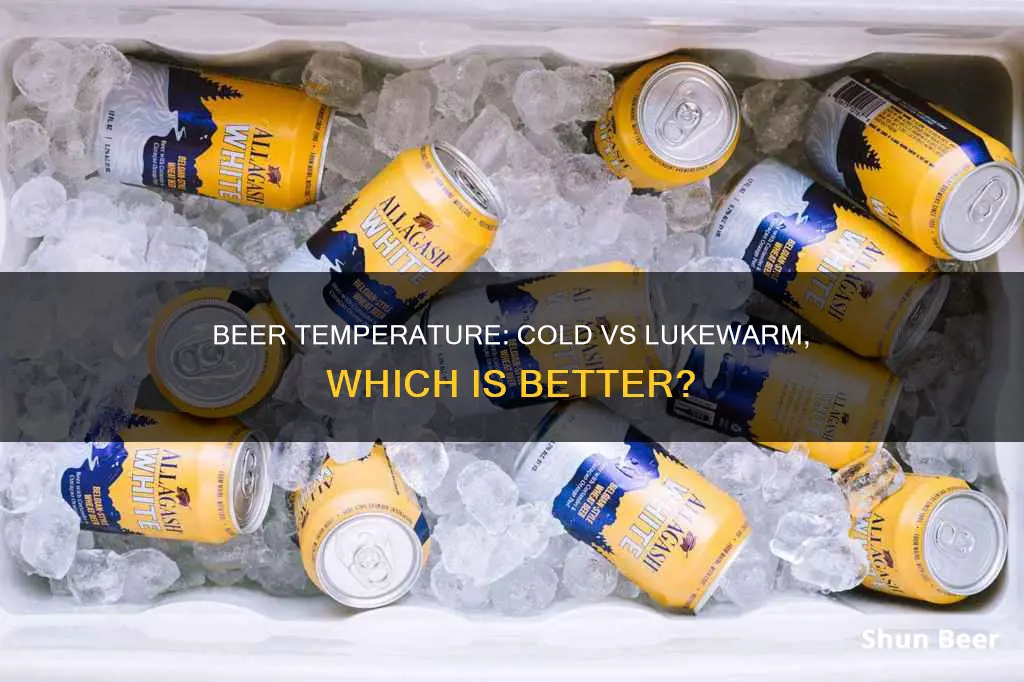
There is a lot of debate surrounding the ideal temperature for serving beer. While many people enjoy an ice-cold beer, particularly on a hot day, this can actually mask the nuances in the flavour and aroma of the drink. When beer is served too cold, the cold temperature slows the volatilisation of aromatic compounds, causing them to remain in the beer rather than being released. This can dramatically change the flavour and aroma, sometimes making the beer taste thin and tasteless. However, drinking beer that is too warm can also be unpleasant, as the carbonation and bitterness may decrease, leading to a flat-tasting or even tasteless drink. So, what is the perfect temperature for serving beer?
| Characteristics | Values |
|---|---|
| Ideal serving temperature | Depends on the type of beer, brewing process, tradition, and personal preference |
| Effect of temperature on taste | Colder temperatures can mask flavours and aromas, enhance bitterness, dryness, and carbonation, and make the beer seem thin and tasteless; warmer temperatures can bring out more flavours and aromas, but can also decrease hop bitterness and carbonation, leading to a flat-tasting experience |
| Beer types and ideal serving temperatures | Lagers, pilsners, and light beers: 40-45°F; Dark beers like cask ales and imperial stouts: 50-55°F; Ambers and bocks: in between |
| Beer storage | Beer should be stored in a cool, dark place; unopened beer can last 6-9 months at room temperature, and up to 2 years in the fridge |
What You'll Learn

The ideal temperature range for drinking beer
The ideal temperature for drinking beer depends on the type of beer and your personal preference. While some people enjoy their beer ice-cold, others prefer it at room temperature or warmer. Let's explore the ideal temperature range for drinking beer to enhance its flavour and aroma.
The Impact of Temperature on Beer
Beer is a delicate beverage where temperature plays a crucial role in unlocking its full potential. Serving beer too cold can mask its unique flavours and aroma. The cold temperature slows down the evaporation of aromatic compounds, causing them toremain in the beer. This can alter the apparent flavour and aroma, making the beer taste thin and tasteless. Additionally, the cold can enhance bitterness, dryness, and carbonation, resulting in an unpleasant drinking experience.
On the other hand, serving beer too warm can be equally detrimental. As beer approaches room temperature, the carbonation and sensations from hop bitterness decrease, leading to a flat-tasting or even tasteless beer. Therefore, finding the right temperature is essential to enjoy the delicate flavours and aromas of your beer.
Recommended Temperature Ranges
While there is no universal temperature that suits all beers, some general guidelines can help you make informed decisions. Firstly, all beers should be served between 34°F and 55°F (some sources suggest 38°F to 55°F). Within this range, different styles of beers have their optimal temperature zones:
- Lagers, including American light lagers, pale lagers, and pilsners, are best served cold, between 34°F and 45°F.
- Wheat beers, such as blond ale and cream ale, and Hefeweizen, are recommended to be served slightly warmer, between 40°F and 45°F.
- IPAs, porters, stouts, and American pale ales flourish in the cool temperature range of 45°F to 50°F.
- Dark and rich beers, such as imperial stouts, cask ales, and Belgische: bocks, are best appreciated at warmer temperatures, between 50°F and 60°F.
Additional Considerations
When serving beer, it is essential to consider that beers tend to warm up quickly, so it is best to enjoy them before they get too warm. The type of glassware also matters; easy-drinking beers are typically served in large mugs, while a pint glass is suitable for slower drinking, as it takes longer for the beer to warm up.
In conclusion, while personal preference plays a role in how cold or warm you like your beer, finding the right temperature range for each style of beer can significantly enhance your drinking experience. So, the next time you reach for a beer, remember that serving it at the ideal temperature will allow you to savour its unique nuances, flavours, and aromas fully.
Crafting Beer: My Career Choice and Passion
You may want to see also

How temperature affects the taste of beer
Beer is usually associated with being ice-cold, but drinking it at a freezing temperature might not be the best way to enjoy it. Serving temperature can significantly impact a beer's taste, and each type of beer has a corresponding ideal serving temperature. While it ultimately depends on the drinker's preference, some general rules can help you make the most of your beer.
The Effect of Cold Temperatures
Chilling beer enhances some qualities while muting others. The biggest issue with serving beer too cold is that it can mask many flavours and aromas. The cold temperature slows the volatilisation of aromatic compounds, causing them to linger in the beer. This dramatically changes the apparent flavour and aroma, sometimes making the beer taste thin and tasteless. The cold also enhances bitterness, dryness, and carbonation, which can make for an unpleasant drinking experience if paired with a thin, tasteless beer. Overly chilled beer can also become hazy, and the increased carbonation can give it an unpleasant "tingle".
The Effect of Warmer Temperatures
On the other hand, warmer temperatures allow more of the flavours and aromas to come to the forefront. However, as beer approaches room temperature, the sensations from hop bitterness and carbonation can decrease, leading to a flat-tasting or even tasteless beer. Warmer temperatures can also make the flavours and aromas overpowering.
General Temperature Guidelines
The acceptable temperature range for serving beer is between 34 to 55 degrees Fahrenheit (some sources suggest 38 to 55 degrees Fahrenheit). Lagers are served colder than ales, and darker beers are served warmer than lighter beers. Stronger beers are also served warmer than weaker beers. Commercially produced light lagers, such as traditional American brews, flourish in cold temperatures, with an ideal range of 34 to 45 degrees Fahrenheit. Wheat beers, pilsners, and other light beers are best served at 40 to 45 degrees Fahrenheit, while dark styles like cask ales and imperial stouts are ideal at 50 to 55 degrees Fahrenheit. Ambers and bocks fall somewhere in between.
Beer and Ceft: A Safe Mix?
You may want to see also

The pros and cons of drinking beer at room temperature
Drinking beer at room temperature has its pros and cons. On the one hand, drinking beer at warmer temperatures can allow you to appreciate the beverage's nuances and ingredients, as the warmth intensifies the beer's flavours and aromas. For instance, sweeter beers like barleywines, imperial stouts, and doppelbocks are best served just under room temperature, at around 60°F, to let their sweet malty aroma bloom over the bitter base notes. Beers with strong flavours, such as imperial stouts, are also better served warm.
On the other hand, drinking beer at room temperature can be an unpleasant experience. The warmth can strip the beer of its delicate flavours, making it taste flat or tasteless. The carbonation and bitterness of the beer may also decrease as it reaches room temperature.
In addition, drinking beer at room temperature can shorten its shelf life. Keeping beer at room temperature can reduce its shelf life from nearly six months to only a few weeks. Exposure to very warm temperatures can affect its flavour in a matter of a couple of days.
However, temperature cycling—the process of warming and then cooling beer—does not affect its quality.
Beer and Cholesterol: Is There a Link?
You may want to see also

How temperature affects the shelf life of beer
The temperature at which beer is stored and served can have a significant impact on its flavour and freshness, as well as its shelf life.
Freshness
Firstly, heat can cause beer to go off, and the higher the temperature, the faster it will spoil. According to the 3-30-300 rule, beer stored at 90°F will last only 3 days, whereas at 72°F (room temperature), it will last 30 days, and at 38°F, it will last up to 300 days.
Flavour
Beer is best preserved when kept cold, and refrigeration can extend its shelf life by several years. Beer kept at room temperature will have a shelf life of around 5-9 months, but its flavour will be impacted. The ideal temperature for serving beer is between 38-55°F, as this allows for the optimal release of flavours and aromas. Warmer temperatures can diminish hop flavours and aromas, and malt flavours may begin to taste generic and overly sweet.
Historical Perspective
Interestingly, the preference for drinking cold beer is a recent development. In the 19th century, it was common to be served warmed ale during the winter months, and warm beer was said to aid digestion.
Other Factors
Other factors that can affect the longevity of beer include oxidation, UV exposure, and bacteria. Oxidation occurs faster at higher temperatures and can result in cardboard or sherry-like flavours. UV rays can cause a chemical reaction that produces the same chemical found in skunk spray, giving the beer an unpleasant taste and aroma. Foreign yeasts and bacteria can also proliferate in room-temperature beer, producing sour or yeasty flavours.
Beer and Bowel Movements: Constipation Concerns?
You may want to see also

The history of drinking warm beer
Drinking beer ice-cold is now considered the norm, but this wasn't always the case. In fact, drinking warm beer has a long history that dates back centuries. Here is a brief overview of the history of consuming warm beer.
The Early Days of Beer:
From the beginning of civilisation until the advent of refrigeration in the 20th century, drinking warm beer was the norm. In the early days, beer was served at ambient temperature, and later it was cellared to be barely cooled. The act of chilling beer was uncommon and often impractical without modern refrigeration technology.
The Rise of Mulled Ales:
From the 1600s to the 1800s, "mulled ales" or heated beers were all the rage. Walking into any tavern during this period would provide ample opportunity to partake in this fashion of the day. The belief that warm beer was healthier than cold beer was prevalent. People thought that drinking cold beer would upset digestion and vapourous humours.
Health Benefits and Taste:
Heated ale was often perceived as more wholesome and beneficial for health. Writings from the 17th century, such as "Panala Alacatholica" and Henry Overton's pamphlet "Warme Beere," extolled the virtues of warm beer for nourishment and comfort. Additionally, warm beer was believed to aid digestion and was used in recipes for warm porridges and flips (a mixture of dark ale, rum, and sugar).
The Role of Refrigeration:
The introduction of artificial refrigeration and the rise in popularity of lager beer, which was brewed to be consumed cold, contributed to the decline of heated ales. Americans enthusiastically embraced light, crisp, ice-cold lagers, and the preference for chilled beer gradually spread.
Regional Preferences and Craft Beer Revival:
It is worth noting that the shift towards chilled beer occurred at different times in different regions. Even today, in Europe, it is much more common to drink beer at room temperature. Additionally, with the rise of craft beer enthusiasts and homebrewers, there has been a resurgence of interest in drinking beer at warmer temperatures to fully appreciate the nuances of flavour and aroma.
So, while drinking ice-cold beer may be the modern standard, the history of beer consumption tells a different story, with warm beer being the preferred choice for centuries.
Beer After Best Before: Is It Safe to Drink?
You may want to see also
Frequently asked questions
Yes, drinking beer at room temperature is completely safe.
Yes, the temperature of the beer can significantly impact its taste.
The ideal temperature for serving beer depends on the type of beer and the drinker's preference. However, a general rule is that beers with a strong flavour or darker beers are best served warm, while light-bodied, low-alcohol beers are best served cold.
No, the temperature of the beer does not affect how drunk you will get. However, the placebo effect of expecting a higher alcohol content can make you feel drunker.
An unopened bottle of beer can last between 6 to 9 months at room temperature.







